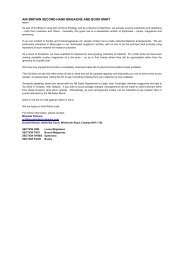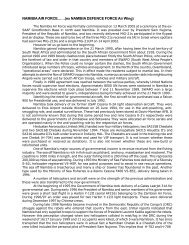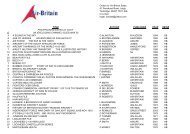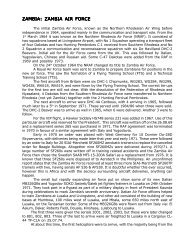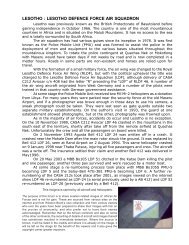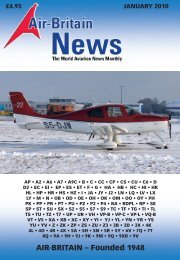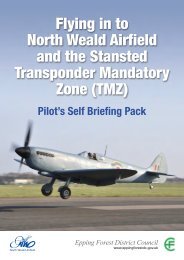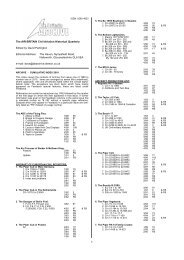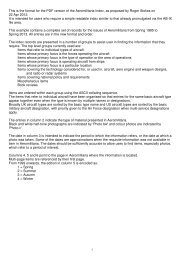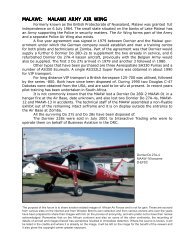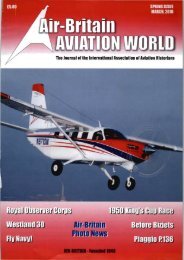Botswana - Air-Britain
Botswana - Air-Britain
Botswana - Air-Britain
- No tags were found...
Create successful ePaper yourself
Turn your PDF publications into a flip-book with our unique Google optimized e-Paper software.
found their way to <strong>Botswana</strong>. This was confirmed in April 1997 when the Strikemasters were disposed ofand registered to Global Aviation of Binbrook. Amongst the registrations were Strikemasters with Kenya<strong>Air</strong> Force serials.One (OJ5) crashed at an air display on 29.04.89 and another two (OJ4 & OJ9) crashed nearGaberone on 12.12.89, when they are believed to have collided in mid-air and both pilots ejected safely.For VIP transport a British Aerospace BAe 125-800B was purchased in 1988. This aircraft forcelandedin Angola after being attacked by Angolan <strong>Air</strong> Force MiG-21s on 08.08.88. One engine was destroyedand the pilot did well to land on only one engine. It was returned for repairs in December 1988 andsubsequently sold in South America. Another BAe 125-800B was supplied on 15.03.90 and has also sincebeen sold as G-OBLT on 15.07.92. This was replaced by a Grumman Gulfstream IV.It was announced on 4 June 1996 that 13 of the 36 upgraded Canadian <strong>Air</strong> Force CF-116(CF-5’s)were to join the <strong>Botswana</strong> Defence Force <strong>Air</strong> Arm, with the first to be delivered in August of 1996 and thelast during 1997. These CF-116 fighters became surplus to Canadian requirements, and were retiredduring 1995. The US$50million deal was brokered by Bristol Aerospace, who were responsible for preparingthe aircraft for delivery, providing logistic support and maintenance training. The deal consisted of ten CF-116s (single seat) and three CF-116D’s (dual seat). In addition, new electronics, cockpit controls, head-updisplays and weapons targeting systems were provided as part of the Canadian <strong>Air</strong> Force upgrade. Theaircraft were to have new radios installed and revised IFF systems.Serials are in the range OJ1 - OJ10, with OJ2 being seen at the factory in Canada before delivery.This same OJ2 was to make a wheels-up landing at Gaberone International <strong>Air</strong>port during 1997 and wasdamaged extensively. It is a possible write off. With the exception of OJ2 tie-ups are assumed. Another 4dual-seaters were to follow. OJ25 was seen at AAD at Waterkloof AFB.During 1995/96 the <strong>Botswana</strong> Defence Force <strong>Air</strong> Arm was offered two ex-USAF C-130B Hercules.During this same period other <strong>Air</strong> Forces such as the SAAF and the <strong>Air</strong> Force of Zimbabwe were alsooffered the Hercules. The SAAF accepted five Hercules and the AFZ declined the offer because of financialrestraints. The first <strong>Botswana</strong> DF <strong>Air</strong> Arm Hercules arrived during early 1997 and was shown to the publicon the occasion of the 20th Anniversary of the <strong>Botswana</strong> Defence Force on the 29th April 1997. It receivedthe serial OM1.The <strong>Air</strong> Arm has taken delivery of a number of Aviatika 890U Mais (Streak Shadow) from theagents at Wonderboom <strong>Air</strong>port in South Africa. One, c/n 74 was seen awaiting delivery on 1.10.97. Althoughthe plate on the aircraft had the c/n 73 ?? Delivery is believed to have taken place on 7.11.97.The another arrival has been the Dornier 328 ....OB2....on the 1st November 2008. Latest arrivalhas been a Bombardier BD700 Global Express...OK1(4) on 18th September 2009. The earlier GulfstreamIV, OK1 (3) (which has not been sold) has been allocated the serial OK2.New <strong>Botswana</strong> <strong>Air</strong> Base “Thebe-Phatshwa” at MOLEPOLOLEFrench, South African, British and Italian firms built an airbase for the BDF <strong>Air</strong> Arm at Molepololeabout 80km north west of Gaberone. Project Eagle was to cost a total of US$350 million, and was fundedby a French government loan.The French firm Spie Batignolles was awarded the major portion, some US$230m of the constructioncontract. Sir Alexander Gibb and Partners were the consulting engineers, and LTA of SA was a major subcontractor.The base was to have two runways with four alert pads, four hangars and the usual aviationand accommodation facilities. It is reported to be spread over some 30sq kms.Project Eagle was approved in 1989 and construction began in 1990. The completion date was setfor 1992, but poor access roads hampered construction. Completion was scheduled for 1995.The purpose of this forum is to share aviation related images of African <strong>Air</strong> Forces and is not for gain. These are sourcedfrom various sites on the internet and from Winston Brent’s own collection and from various owners who over the yearshave been prepared to share their images with him on the proviso of anonymity, and who prefer not to have their namesacknowledged. Remember that on the African continent and also on some of the other continents, the recording ofdetails of aircraft and images thereof has sometimes resulted in immediate detention. Where the source is known, it willbe listed in the credits and where it is already on the image, it will be left on the image for the benefit of the viewers andit also gives the copyright owner greater exposure.




